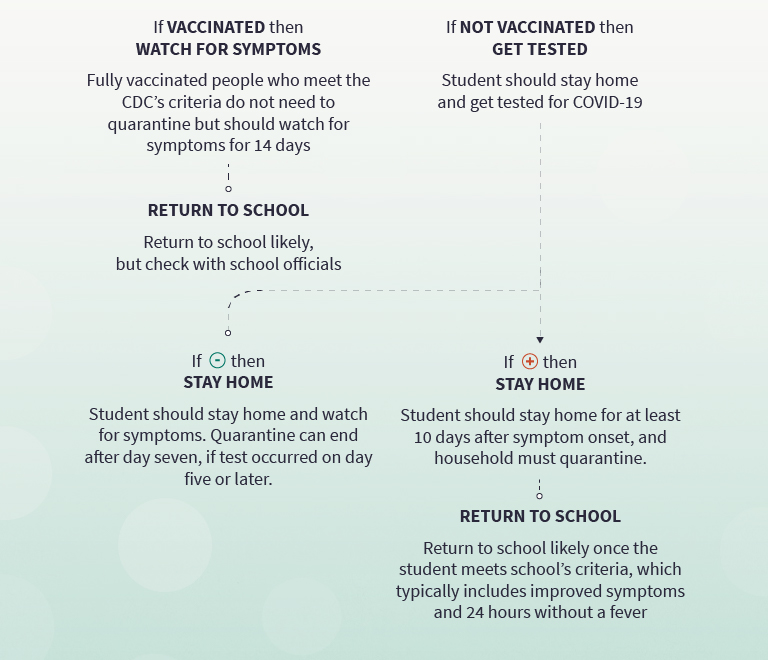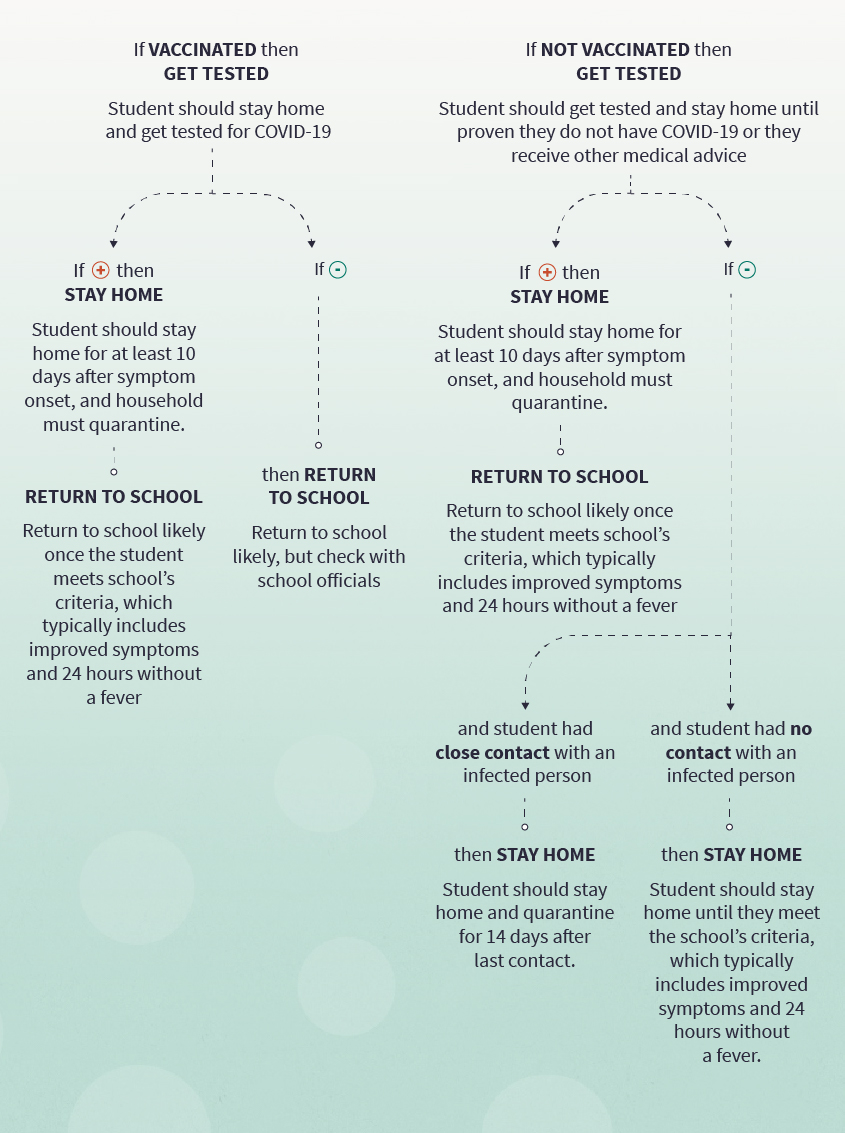How to Understand School Protocols for COVID-19 and Vaccines

As vaccination for the coronavirus continues and schools prepare for reopening, Eileen Moss, DNP, encourages families to have patience. Clinical trials are still underway, and updating COVID-19 school protocols will take time and careful planning.
“The science has to catch up to the process of the implementing, and until there are research studies that support guaranteed immunity, we’re not going to see a change in [COVID-19 school protocols],” said Moss, who is the lead nurse of an Illinois school district.
The following guide can help families better understand how their school districts, school nurses and local officials are managing the coronavirus pandemic and vaccination rollout.
COVID-19 School Protocols: Terms to Know
The COVID-19 pandemic and the resulting changes to school protocols introduced new terms into the vocabulary of parents and educators. Learn more about immunity, vaccination and more below.
Active vs Passive Immunity: Active immunity is developed when an individual is exposed to a disease organism either through infection or vaccination and their immune system develops antibodies to that disease. Passive immunity happens when an individual receives antibodies to a disease rather than produces them through their own immune system.
Alternate (Alternative) Diagnosis: For schools managing coronavirus spread, this is documentation that a student’s symptoms are caused by a condition other than COVID-19.
Asymptomatic and Presymptomatic: An individual who is asymptomatic is infected but shows no signs or symptoms of illness; someone who is presymptomatic will develop symptoms later.
Close Contact: The CDC defines a close contact as someone who was within six feet of an infected individual for “a cumulative total of 15 minutes or more over a 24-hour period,” starting two days before illness onset or a positive test.
Contact Tracing: In this virus containment strategy, public health staff help individuals remember with whom they had close contact while potentially infectious and alert contacts of their possible exposure.
Congregate Settings: These settings are places where a number of people live, meet or gather in close proximity for either a limited or extended period of time (e.g., nursing home, schools, prisons, workplaces).
Containment Strategies: Containment efforts promote the prevention of a contagious disease through quarantine and contact tracing.
Infectious Disease Exclusion Guidance: Also called a decision or exclusion tree, these recommendations from public health officials help school nurses and administrators determine when to “exclude” a child from school to prevent the spread of an infectious disease.
Fully Vaccinated: An individual is considered fully vaccinated two weeks or longer after receipt of the second dose in a two-dose series or of one dose of a single-dose vaccine. The CDC does not recommend additional doses beyond the two-dose series as of March 3, 2021.
Herd Immunity: When a high percentage of a community is immune to a contagious disease, herd immunity is achieved, which means further spread of the virus is unlikely.
Mitigation Strategies: When a disease outpaces containment efforts, mitigation efforts are used; these non-pharmaceutical interventions include hand hygiene, travel restrictions and school closures.
Presumptive Positive vs Confirmed Case: A presumptive positive result means that an individual has tested positive for the coronavirus at a public health laboratory, but the results have not been confirmed by the Centers for Disease Control and Prevention (CDC). A confirmed case has been confirmed by the CDC.
Quarantine vs Isolation: Quarantine is separating and limiting the movement of individuals who have or may have been exposed to the disease allows them to be monitored for signs of illness. Public health experts recommend isolation, or separation of an individual who is sick with a contagious disease from those who are not, to prevent spreading the virus.
What Parents Need to Know About COVID-19 School Protocols
Parents should note that as of February 2021, the FDA has not authorized any COVID-19 vaccine for children under 16. This guidance applies to students aged 16 years and older in states where they qualify to receive the vaccine and aligns with the CDC’s most recent interim guidance for COVID-19 vaccines.
Readers should also consider that this guide does not address individuals who have only received a partial dose (or one dose in a two-dose series) of the COVID-19 vaccine.
How Can Families Follow School Protocols During the Coronavirus Pandemic?
This decision tree should not replace information from the child’s school district or health providers. Families should seek out specific guidance from their state department of health, their school officials and their own healthcare providers. As more becomes known about the COVID-19 vaccine, these suggestions are likely to change.
Scenario A: Student Exposed to a Confirmed Case

This guide should not take the place of recommendations from local school and public health officials. Students who have received a full dose of the COVID-19 vaccine may be able to return to school without a quarantine period after a coronavirus exposure, according to the latest CDC guidance in February 2021. Students who have not received the vaccine should stay home from school if exposed to the coronavirus and get tested. A positive result means the student and their family should quarantine and recover, returning to school only when they meet their local school and public health officials requirements. A student with a negative result should still stay home and watch for symptoms. Quarantine can end after day seven if the test occurred on day five or later.
Scenario B: Household Member Has COVID-Related Symptoms
Common COVID-19 Symptoms
- Fever
- Cough
- Tiredness
- Loss of taste or smell
- Muscle aches
- Chills
- Shortness of breath or difficulty breathing
- Sore throat
- Runny nose
- Headache
- Chest pain
- Pink eye (conjunctivitis)
Source: Mayo Clinic, Coronavirus Disease 2019 (COVID-19). Accessed February 18, 2021.
Assume the household member has COVID-19 until proven otherwise. Regardless of vaccination status, the symptomatic individual should isolate. Everyone else should wear masks around them.

This guide should not take the place of recommendations from local school and public health officials. Students who have received a full dose of the COVID-19 vaccine may be able to return to school without a quarantine period after a coronavirus exposure at home, according to the latest CDC guidance in February 2021. Students who have not received the vaccine should stay home from school if exposed to the coronavirus and get tested. A positive result means the student and their family should quarantine and recover, returning to school only when they meet their local school and public health officials requirements. A student with a negative result should still stay home and watch for symptoms. Quarantine can end after day seven if the test occurred on day five or later.

This guide should not take the place of recommendations from local school and public health officials. A student who has COVID-related symptoms should stay home and get tested. For those who are vaccinated, a negative result means a likely return to school. A positive result means the student should stay home and quarantine. Non-vaccinated students who receive a positive result should stay home and quarantine. Non-vaccinated students with a negative result should also stay home and quarantine — for 14 days if they had close contact with an infected individual or, if they did not, until they meet their local school and public health officials requirements for returning.
Sources:
CDC, Screening K-12 Students for Symptoms of COVID-19: Limitations and Considerations. Accessed February 24, 2021. _https://www.cdc.gov/coronavirus/2019-ncov/community/schools-childcare/symptom-screening.html#flowchart_
CDC, When to Quarantine. Accessed February 25, 2021. _https://www.cdc.gov/coronavirus/2019-ncov/if-you-are-sick/quarantine.html_
Georges C. Benjamin, MD, executive director of the American Public Health Association, and Eileen Moss were consulted in late January 2021.
COVID School Guidance for Parents
It’s critical for families to cooperate with school officials.
“It may seem frustrating for parents if we’re sending home a student for a runny nose, or even a severe headache,” said Gabriella Barrera, president of the Illinois Association of School Nurses. However, if there is no alternative diagnosis documented in the health office, school officials have to assume the child has COVID-19 in order to prevent potential spread.
Everyone, including those who have been vaccinated, should continue to wear masks.
The CDC’s FAQ page about COVID-19 vaccines explains that experts do not know to what extent vaccinated individuals are able to spread the virus. Parents should also note that models find individuals with no coronavirus symptoms account for up to 59% of spread. For all of these reasons, everyone should continue wearing masks.
It will take time for COVID-19 school protocols to change.
“We’re all in one big research study, and we just have to wait for the results,” said Moss. Over time, public health and education officials will learn more about the protection offered by the COVID-19 vaccine and adjust their recommendations accordingly. Until then, families should follow the available guidance from trustworthy sources, including the CDC, World Health Organization and local authorities.
Assume COVID-related symptoms are COVID-19.
The safest option for families is to assume that COVID-related symptoms are actually from COVID-19, even in vaccinated people, until a negative test, quarantine period or alternative diagnosis from a health provider indicates otherwise. As reminder, coronavirus symptoms can appear 2–14 days after exposure to the virus and may include:
- Fever or chills
- Cough
- Shortness of breath or difficulty breathing
- Fatigue
- Muscle or body aches
- Headache
- Loss of taste or smell
- Sore throat
- Congestion or runny nose
- Nausea or vomiting
- Diarrhea
Keep protecting yourself, your kids and your community from the coronavirus.
Even after vaccination, the CDC’s recommended coronavirus safety measures include wearing a mask that covers the nose and mouth, maintaining six feet of distance from those outside the household, avoiding crowds and poorly ventilated spaces and washing hands often.
To learn more about COVID-19 resources, read our guides on Learning About the Coronavirus: Resources for Children and Families and Information on Masks in the Coronavirus Pandemic—All in One Place.
Where to Find Out More About COVID-19 Protocols in Schools
Families should consult their state’s department of education website for information specific to their children’s school district. The following COVID-19 resources can also provide a starting point for research:
- Coronavirus Disease (COVID-19): Schools | World Health Organization: frequently asked questions about the impact of COVID-19 on children and education.
- COVID-19 Resources and Information | ChildCare.gov: landing page of information for COVID-19 and children specific to states and territories.
- COVID-19 Resources for Schools, Students, and Families | U.S. Department of Education: source for updates to COVID-19 policies related to elementary and secondary education, special education, higher education and lifelong learning.
- National COVID-19 School Response Dashboard: dashboard enabling users to view COVID-19 cases alongside reopening data from individual schools, districts and states.
- Resources for Learning at Home | U.S. Department of Education
- Trusted Resources | Dear Pandemic: list of credible and timely sources of COVID-19 education, including multilingual resources.
Please note that this article is for informational purposes only. Individuals should consult their health care provider before following any of the information provided.
